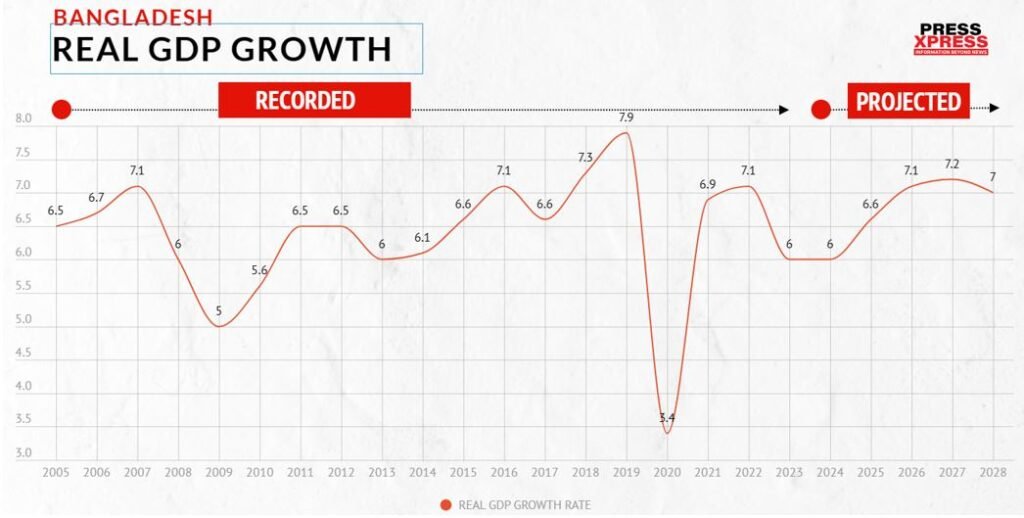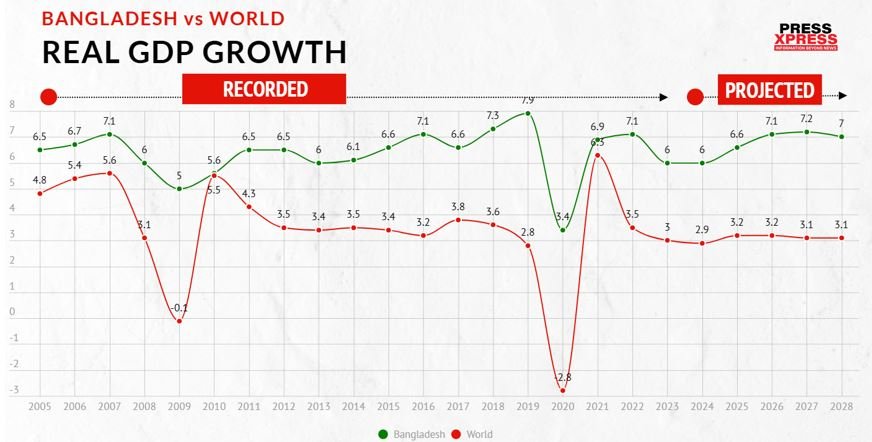In a long span of time, Prime Minister Sheikh Hasina’s voice has sparked an aspiration among the people for a better life, particularly for the youths to grow. In a way, even ordinary people are engaged in an economic race to change as well as build up their own fate. This has had a strong stamping impact with enormous dynamics on the country’s development and GDP for sure.
This is how Bangladesh has been placed as one of the fastest-growing economies in Asia, but amid the ongoing Russo-Ukrainian war and other domestic and external challenges, is facing a slowdown in its growth momentum. The World Bank’s latest Global Economic Prospects report, released on January 11, projected that the country’s gross domestic product (GDP) growth would slow down to 5.6 percent in the current fiscal year (FY24), the lowest rate in more than a decade, excluding the pandemic-hit FY20. The report also warned that the global economy is on a precarious footing, with the slowest half-decade of growth in 30 years.
The World Bank’s projection for Bangladesh is unchanged from its October update, but lower than the government’s revised target of 6.5 percent growth. The government had initially set a 7.5 percent growth goal for FY24, but later scaled it down due to the adverse impact of external and internal factors, such as import restrictions, higher material and energy costs, and external and financial pressures, that slowed down the economic growth to 6 percent in FY23.
Government Targets Inflation and FE reserves
A finance ministry official has told the media that the government is not aiming for a higher GDP growth this fiscal year, but rather focusing on containing inflation and increasing the foreign exchange reserves. “Our aim is to maintain macroeconomic stability and create a conducive environment for investment and job creation,” the official said.
The World Bank report said that the economic growth in Bangladesh is expected to rebound in the next fiscal year (FY25) as inflationary pressure eases, external conditions improve, and reform implementation gains momentum. The report also praised Bangladesh’s remarkable story of poverty reduction and development, noting that the country reached lower-middle income status in 2015 and is on track to graduate from the UN’s Least Developed Countries (LDC) list in 2026.
However, the report also highlighted the challenges and risks that Bangladesh faces in achieving its vision of attaining upper middle-income status by 2031. Among them are the persistent macroeconomic challenges caused by a sharp decline in the foreign exchange reserves in the past two years, which stood at $20.38 billion on Monday, down from $40.7 billion in August 2021. The report said that the balance of payments is projected to return to a surplus over the medium term as financial inflows recover and remittance inflows rise, supported by strong demand for workers in the Gulf region.
Another challenge is the high inflation, which averaged 9.02 percent in FY23, the highest in more than a decade, and stood at 9.49 percent in November. The report said that inflation is likely to remain elevated in Bangladesh, weighing on private consumption, and urged the government to ramp up monetary and fiscal measures to address inflationary pressures. The report also suggested that the government should enhance fiscal sustainability by generating higher revenues, making spending more efficient, and improving debt management practices.

Diversification of Exports Crucial for Sustainability
A third challenge is the diversification of exports beyond the ready-made garment (RMG) sector, which accounts for more than 80 percent of the country’s export earnings. The report said that slower-than-anticipated growth in the country’s export destinations, particularly in the European Union, could pose a risk to growth prospects. The report also recommended that the government should improve the business environment, address infrastructure gaps, and foster innovation and human capital development to boost the competitiveness and productivity of the export sector.
An Optimistic Outlook
Despite the slowdown, Bangladesh will still be among the top performers in Asia in terms of GDP growth in FY24, according to the World Bank report. The report projected that only five countries in Asia, which comprises 48 nations covering the Pacific, East Asia, Central Asia, the Middle East, and South Asia, will have higher GDP growth rates than Bangladesh in FY24: Cambodia, Mongolia, Palau, the Philippines, and India.

The report also said that Bangladesh’s projection is comparatively higher than the global average, which is set to slow for the third year in a row, from 2.6 percent in 2022 to 2.4 percent in 2024. The report attributed the global slowdown to high inflation, tight monetary policy, and more restrictive credit conditions, and warned that the possibility of more widespread bank turmoil and tighter monetary policy could result in even weaker global growth and lead to financial dislocations in the most vulnerable emerging market and developing economies.
The report called for comprehensive policy action to foster macroeconomic and financial stability and urged continued international cooperation to tackle climate change, support populations affected by crises and hunger, and provide debt relief where needed. The report also said that without a major course correction, the 2020s will go down as a decade of wasted opportunity. “The world economy remains hobbled—far short of the strength that will be necessary to make substantial progress on global ambitions to eliminate extreme poverty, counter climate change, and replenish human capital,” said Indermit Gill, chief economist and senior vice president of the World Bank. Bangladesh too, must adapt to changing global circumstances in order to maintain a sustainable economic growth.


